
Here’s a parish-by-parish look at state-record book bucks that shows a hunter needs to hunt north of US 190 if he wants to see his name in print.
It is obvious there are certain Louisiana parishes that seem to ooze with trophy class deer.
This is not ground-breaking news; most local hunters are aware of this.
In Louisiana, as in most states, it’s all about nutrition. The parishes with the best nutrition grow the biggest bucks. It’s not quite that simple, but nutrition is the key. Add in the age requirement using a sound, management harvest program that allows desirable younger bucks to grow older, and let nature do what nature does best.
In Louisiana, the bottomland hardwood forests in the Mississippi Delta with the forage and grain crops being grown is big-buck habitat. This also applies to the bottomland and farmland parishes along the Red River. Parishes that still have mixed pine/hardwood habitat where there is a good oak component will also grow quality and trophy bucks.
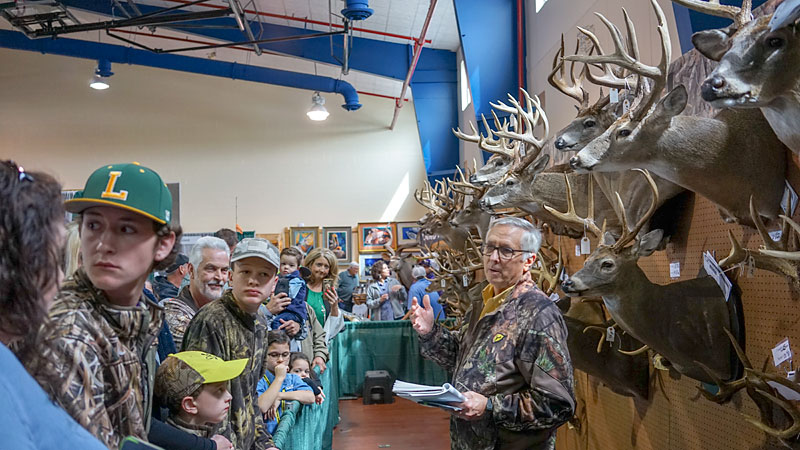
The landscape around the state has changed from what it was 50 years ago. Urbanization has taken its toll on rural areas within an hour’s drive of major cities such as Baton Rouge, Shreveport, Monroe, Alexandria and Slidell. Hurricane Katrina played a major role in urban sprawl in the Florida parishes. The forest landscape has changed dramatically, with forests becoming more pine dominated, which has an impact on the ability of the habitat to grow big bucks. The Kisatchie National Forest has a forest plan that now emphasizes long-leaf pine, great for some game species but not known for being big-buck habitat.
Three buck-limit
On the plus side, Louisiana implemented a three-buck limit years ago; it has made hunters more selective. Many clubs and private landowners have gone to management programs that favor producing quality and trophy deer. Consequently, we are seeing an older age-class of bucks. Public-land hunters are blessed with many areas available that have big-buck habitat. Seasons are set so that hunters can hunt during the rut, the time when big bucks are moving around. Of course, killing a trophy buck is not an easy task, but it does happen every season.
The listings that follow are from the Louisiana Department of Wildlife and Fisheries’ records and from what I have documented over my years of scoring deer. It takes a typical score of 170 to make the Boone & Crockett Club’s all-time record book, and a non-typical score of 195 will put a hunter in the record book.
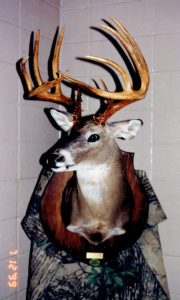
Northwest Louisiana
This is piney woods country, but historically it has been a region where trophy class bucks have been killed. Ernest McCoy killed the No. 2 typical buck in Bossier Parish in 1961. Green Campbell killed the No. 1 non-typical muzzleloader buck in 2007; it scored 2035/8. Since then, it has been somewhat quiet in this region. However, not many bucks that are killed each season get officially scored. Dr. Mark Haynes of Homer is an official B&C measurer, and hunters can contact him along with the LDWF’s Minden office to get a deer scored for the records.
Here is a table of the best bucks on record from the parishes in this area:
Typical Score Non-typical Score
Parish
Bienville 164 none
Bossier 1844/8 185 /8
Caddo 1771/8 2196/8
Claiborne 1773/8 2067/8
DeSoto 1612/8 1902/8
Jackson 163 /8 none
Lincoln 1322/8 1537/8
Red River 1661/8 2231/8
Union 1796/8 1927/8
Webster 1705/8 1957/8
Northeast Louisiana
This is the land of bottomland hardwood forests and year-round agriculture. Historically, this has been a major deer area in the Louisiana. The old Chicago Mills Game Management Area, now the Tensas River National Wildlife Refuge, was a major source of deer for restocking in the state. It is the home of our No. 1 typical buck, killed in 1943 in Madison Parish by Don Broadway. It is also the home of our No. 1 non-typical buck, killed by James McMurray in 1994 on Big Lake WMA in Tensas Parish. This buck was recognized by the Boone & Crockett Club as the highest-scoring non-typical killed in North America that year. Trophy gun and bow deer continue to be killed annually in this region. East Carroll Parish probably has more bow kill records than any parish.
Here is a table of the best bucks on record from each parish in the area:
Typical Score Non-typical Score
Parish
East Carroll 1703/8 (bow kill) 1777/8
Franklin 1842/8 none
Madison 1846/8 (No. 1) 2065/8
Morehouse 1724/8 none
Ouachita 164 150
Richland 1771/8 1774/8
Tensas 1797/8 286/8 (No. 1)
West Carroll 1513/8 none
Central/West Central Louisiana
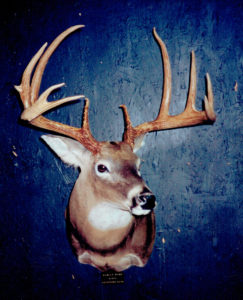
This region has produced some trophy bucks in the past, but not the numbers of the two northern regions. Grant, Natchitoches and Winn parishes seem to have the most records from the region. The Kisatchie National Forest occupies much of the landscape and provides the public with deer hunting opportunity.
Here is a table of the best bucks on record from each parish in the area:
Typical Score Non-typical Score
Parish
Caldwell 161 none
Catahoula 1603/8 none
Grant 1733/8 2131/8
LaSalle 177 7/8 none
Natchitoches 1705/8 none
Rapides 177 none
Sabine 1626/8 none
Vernon 171 none
Winn 1706/8 none
Lower Mississippi Delta/ Upper Atchafalaya Basin
This is the region of the state where I predicted the next No. 1 typical will come from. It has not happened yet, but I haven’t changed my mind. It seems like there have been quite a few that just had too many abnormal points that prevented it from scoring as a great typical. Avoyelles and Concordia have the habitat and also public lands for hunters who need a place to hunt. Thistlethwaite WMA is in St. Landry and is a great place to hunt. Pointe Coupee is also coming on strong as a big buk parish.
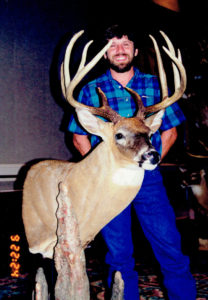
Here is a table of the best bucks on record from each parish in the area:
Typical Score Non-typical Score
Parish
Avoyelles 1811/8 2262/8
Concordia 1775/8 2522/8
Iberville 1285/8 2093/8
Pointe Coupee 1632/8 1834/8
St. Landry 1805/8 1933/8
West Baton Rouge 1511/8 1805/8
Southwest Louisiana
This large area of Louisiana is better known for its duck and goose hunting. That alone should make it clear that the landscape here is marsh and rice fields, great habitat for waterfowl, but it does not have the nutrition needed to grow the big bucks. The records clearly show that this is not the place to go to kill a trophy.
Here is a table of the best bucks on record from each parish in the area:
Typical Score Non-typical Score
Parish
Acadia none none
Allen 1367/8 none
Beauregard 1522/8 none
Calcasieu 1462/8 1673/8
Evangeline 1351/8 none
Jeff Davis none none
Lafayette none none
Cameron 1362/8 none
Vermilion 1167/8 none
Lower Atchafalaya Basin
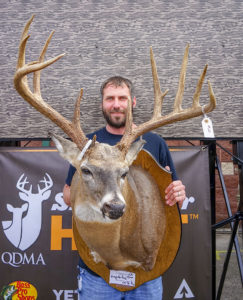
Move eastward from the southwest marshland landscape into the lower Atchafalaya River Basin and its swamp forests. It is habitat for deer, and some areas have enough high ground to grow a quality or trophy bucks, but not in the numbers like the northern parishes. St. Mary seems to have the best habitat, and the Atchafalaya Delta WMA is a good place for bowhunters.
Here is a table of the best bucks on record from each parish in the area:
Typical Score Non-typical Score
Parish
Assumption none none
Iberia 115 none
St. Martin 1387/8 2184/8 (1944)
St. Mary 1765/8 none
Terrebonne 126 167
The Florida Parishes
I believe this is the region of Louisiana where the big-buck habitat has declined the most. I have witnessed this during my wildlife career and now in my retirement years. When I went to work in this region in 1976, it was a landscape dominated by upland hardwood forests and year-round agriculture. Soybeans, corn and winter wheat, along with sweet potatoes in West Feliciana Parish, kept the nutritional level high. Farming stopped in 1985, and the pine tree became the dominant crop. Upland hardwoods are now pine-dominated forests. Urbanization has also taken its toll, changing a rural landscape to one that is urbanized. When I went to work, I actually wondered why they built I-10, but now I try to avoid it whenever possible.
I photographed B&C bucks in West Feliciana Parish in the early 1980s, but now, they are a thing of the past. Clubs and landowners that want to manage for trophy bucks better have some money to spend on a year-round feeding program, because the habitat is now lacking in quality nutrition.
Here is a table of the best bucks on record from each parish in the area:
Typical Score Non-typical Score
Parish
East Baton Rouge 1731/8 none
East Feliciana 1641/8 2035/8
Livingston 1706/8 167
St. Helena 153 175
St. Tammany 153 1573/8
Tangipahoa 1745/8 none
Washington 1482/8 none
West Feliciana 1717/8 2287/8
Lower Southeast LA
Like Southwest Louisiana, the records clearly show that this is not big buck habitat. The landscape is dominated with swamps and marshes with the deer habitat being located on the ridges and levees. This is prime fishing country and one would have a better chance of catching a new state record fish than killing a state record buck.
Here is a table of the best bucks on record from each parish in the area:
Typical Score Non-typical Score
Parish
Ascension 140 none
Jefferson 823/8 1551/8
Lafourche 1352/8 1696/8
Orleans none none
Plaquemines 130 none
St. Bernard none none
St. Charles 119 4/8 none
St. James none none
St. John 1432/8 none
There it is, the parish by parish listing of big bucks. Certainly, not all big bucks have been officially scored, so if you have one that you think is a new parish record, take it to LDWF or another measurer and see what the tale of the tape is.


